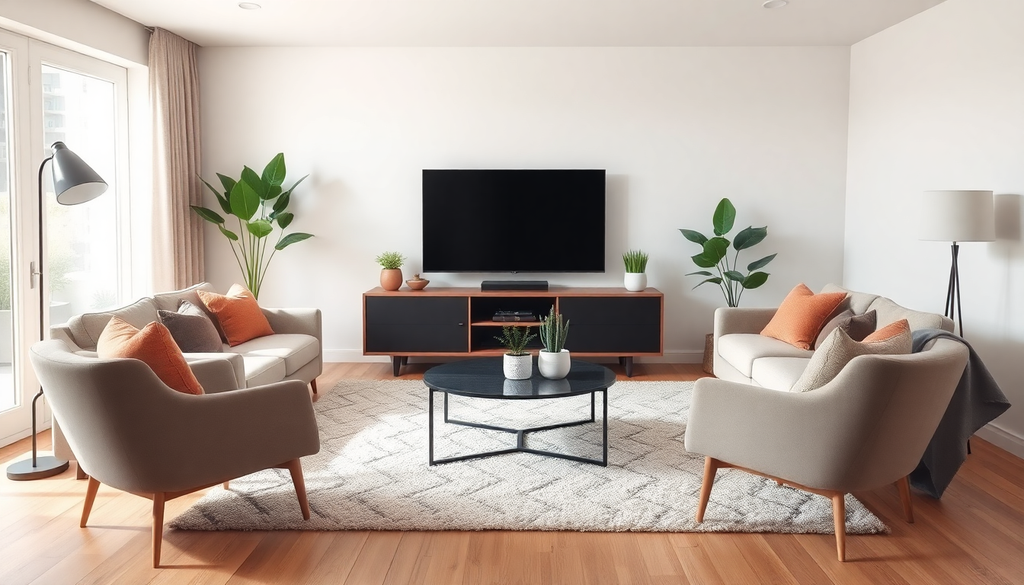Arrange furniture around a focal point like a tv or large artwork

Why a Focal Point Matters in Interior Design
A focal point is your room’s North Star—it guides the eye and sets the stage for how the space functions. Without one, a room feels aimless, like a conversation with no topic. It’s not about overloading the space with drama; it’s about giving it purpose.
Think of it this way: humans are wired to look for visual anchors. Whether it's a fireplace, a massive flat-screen TV, or a towering bookshelf, the focal point is what people notice first. From there, everything else—seating, tables, even rugs—takes cues. The result? A sense of order and balance that doesn’t feel forced.
Here’s why it works: when you establish a focal point, the rest of the design process falls into place. You’re no longer solving for endless possibilities but working to enhance a feature that already commands the room. That kind of clarity makes arranging furniture less about trial and error and more about deliberate choices.
In essence, a focal point eliminates design chaos. It’s like having a lead actor in a play—everything else in the room supports it, creating cohesion and breathing room for everything to shine.
Arranging Furniture Around a TV
The television is often the centerpiece of many living rooms, offering a space to unwind, enjoy a favorite show, or casually doze off during a movie. However, creating a functional and inviting TV setup requires more than just setting up a couch in front of the screen. Follow these tips to nail your living room arrangement.
1. Establish Comfortable Viewing Lines
- Avoid neck strain: Place seating so that every spot offers a clear, direct view of the screen.
-
Optimal screen height: Position the TV so that the center of the screen is at eye level when seated.
- Pro tip: Skip mounting the TV too high, like above the fireplace. Your neck and chiropractor will thank you!
2. Mind the Distance from the Screen
- Screen size matters when deciding how far away to place your seating:
- 55-inch TV: Maintain a distance of 7–9 feet.
- 85-inch TV: Increase the space to around 10 feet.
- Why? Sitting too close highlights pixels, while sitting too far makes viewing details a challenge. Find the sweet spot.
3. Manage Lighting Like a Pro
- Glare can ruin your viewing experience:
- Position the TV and seating to avoid glare from windows or overhead lights.
- Invest in dimmable lights or soft table lamps for cozy, cinema-like ambiance.
- Tackle natural light: Use heavy curtains or blackout shades to block excessive sunlight, especially in bright spaces.
4. Anchor the Room
- Wall-mounted TVs: Flank the screen with bookshelves, cabinets, or plants to create balance.
-
TV consoles: Choose a proportional piece of furniture beneath the TV and keep it minimally styled.
- Storage baskets or decorative accents can add functionality and charm.
5. Don’t Let the TV Dominate
- The TV doesn’t always have to steal the show:
- Use textured throw pillows, artwork, or a stylish coffee table to add variety.
- Introduce personal touches to avoid the space feeling like a media showroom.
In Summary
Crafting the perfect TV-centered living room is all about balance. You're curating a space where technology meets comfort while maintaining the room's personality and functionality. So, sit back, grab the remote, and revel in your beautifully arranged, stylish space.
Furniture Placement for Large Artwork or Photographs

- Artwork as a Focal Point: Large art pieces immediately command attention. Whether it's a bold abstract painting, a serene landscape, or a striking photograph, their scale makes them a natural centerpiece. Data shows that around 8.75% of respondents consider artwork their primary focal point—a relatively small yet impactful percentage. When done right, it sets the tone for the entire room.
- Positioning for Impact: Placement is half the battle. The art should be hung at eye level—measuring 57–60 inches from the floor to the center of the piece is a reliable rule of thumb. This ensures it feels part of the room rather than an afterthought. Anchor the artwork with a complementary piece of furniture directly beneath it—a sofa, console table, or even a sleek credenza. The surrounding furniture should subtly direct attention toward the artwork without feeling forced, like a chair angled slightly inward or a lamp casting a warm glow toward the piece.
- Balancing Furniture with a Statement Art Piece: A large artwork is visually heavy, so balance is vital. Surround it with lighter, airy furniture to give it space to breathe—think slender-legged chairs, minimalist coffee tables, or neutral-toned textiles. Don’t clutter the area; the beauty of a statement piece lies in its ability to stand alone. Let it dominate but not overwhelm. Simplicity wins here. A skilled arrangement should make your statement artwork a quiet hero of the room—effortlessly striking and undeniably magnetic.
Using Fireplaces or Other Architectural Features
- Popular Secondary Focal Points: Fireplaces sit comfortably on the list of go-to focal points, with 20.30% of respondents naming them as their centerpiece of choice. Unlike TVs or statement art, fireplaces carry a practical warmth—both physical and emotional—that few other elements can replicate.
- Maximizing Coziness: The goal here isn’t complicated: lean into the fireplace’s natural ability to create intimacy. Arrange seating in a semi-circle or U-shape to encourage conversation and a sense of togetherness. Push the coffee table within arm's reach but don’t cram it—it’s about connection, not clutter. If the fireplace doubles as a heater, make sure furniture is positioned at a safe but effective distance. Think hygge, but with enough room to stretch your legs.
- Considering Scale and Balance: Fireplaces vary—some dominate the room, while others function as a quieter backdrop. If yours falls into the latter camp, give it some stage presence. Frame it with built-ins or visually stack it by using a mirror, artwork, or a bold mantel display above it. On the flip side, if the fireplace is large and commanding, keep surrounding furniture understated to avoid visual competition. It’s about balance, not a battle for attention.
Optimizing Room Layout for a Central Focal Point
When it comes to creating a room that feels both functional and striking, optimizing the layout around your central focal point is non-negotiable. This process is less about rigid design rules and more about finding the flow that works for both the space and the people using it.
Proportion and Scale
Start by evaluating the size of your focal point in relation to the room and its furnishings. A gargantuan TV or oversized artwork can dominate a small room in all the wrong ways unless balanced thoughtfully. On the flip side, placing a small focal piece on a vast, empty wall often feels like a missed opportunity. The goal? Match visuals with space. For example, a large sectional pairs well with a bold, oversized painting, while a smaller loveseat might work best with a modest gallery frame set off by negative space. Keep the proportions in sync.
Room Flow and Accessibility
A focal point should pull attention, but it shouldn’t hold your room hostage. Flow matters. Ensure furniture placement doesn’t block key pathways—your guests shouldn’t have to awkwardly navigate a maze to grab a drink or exit the room. For open layouts, anchor seating toward the central element without disrupting natural movement through adjoining areas. Think of it as arranging an efficient yet inviting stage set: people can come and go, but their focus still lands where you want it.
Symmetry vs. Asymmetry
Symmetry gives off a polished, formal vibe—perfect for traditional spaces or when the focal point itself demands order (think: a stately fireplace or meticulously framed large artwork). Arrange seating and decor so that everything mirrors across a central axis.
If your style leans more relaxed or you want a sense of vibrancy, play with asymmetry. Offset a sofa with a pair of chairs angled toward the focal point, or layer varying heights and shapes to add depth without sacrificing cohesion. Asymmetry thrives on balance rather than duplication, which keeps the room feeling lively and dynamic.
Ultimately, the trick is to make every piece in your space feel purposeful, while never forgetting that the focal point is the protagonist of your room’s story.
Conclusion
Less guesswork, more intention—focal points are the backbone of a well-designed room. They simplify decision-making by giving you a clear starting line, dictating where your furniture, energy, and attention should go. Whether it's a TV commanding focus, an art piece demanding admiration, or a fireplace drawing people together, the goal remains the same: harmony. A balanced layout isn't about rigid perfection but about creating a space that feels natural and functional. Start with the focal point, and the rest of the room will follow.

